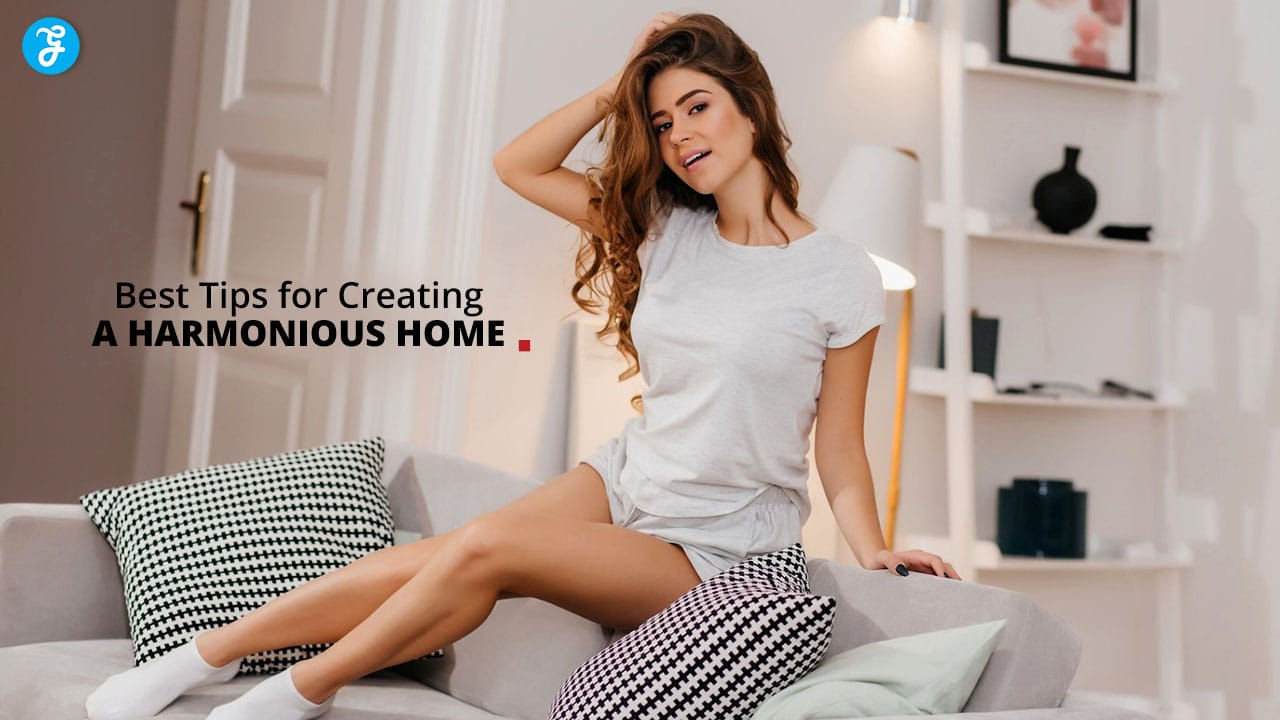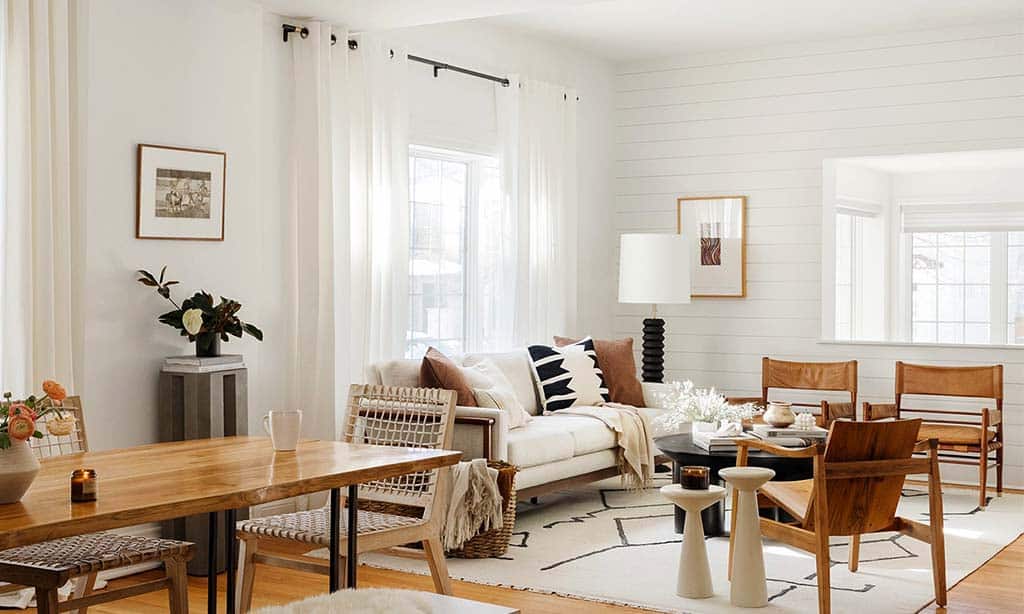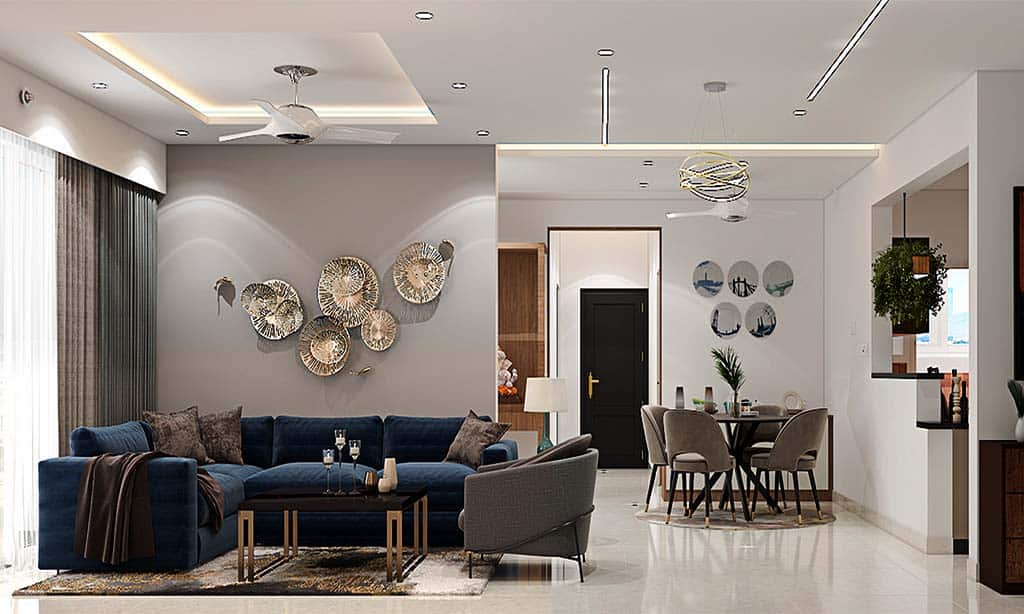Creating a harmonious home is all about balance and thoughtful design choices. A well-designed space can make you feel calm, comfortable, and happy. It’s not just about how things look but also how they work together and make you think.
Good interior design can turn a house into a true home that reflects your personality and meets your needs. You don’t need to be a pro to create harmony in your living space.
With some simple tips and tricks, you can transform your home into a place that feels just right. Explore some of the best ways to bring harmony to your home through innovative design choices.
1. Utilize Neutral Color Palettes
Neutral colors are the secret to a harmonious home. They create a calm backdrop for your space. Think whites, beiges, grays, and soft browns.
Start with a neutral base for your walls. This gives you the flexibility to change up other elements. You can add pops of color through accessories and artwork.
Mix different shades of neutrals to add depth. Use lighter tones on walls and darker ones for furniture. This creates visual interest without being overwhelming.
Texture is critical when working with neutrals. Add softness with plush rugs and cozy throws. Incorporate natural materials like wood and stone for warmth.
Don’t forget about lighting. Soft, warm lighting enhances the cozy feel of neutral spaces. Use lamps and dimmer switches to control the mood.
Neutral doesn’t mean boring. You can still have fun with patterns. Try geometric prints or subtle stripes in similar shades.
Plants are a great addition to neutral rooms. They bring life and a touch of color without disrupting the calm vibe.
Remember, neutrals are versatile. You can easily update your space by swapping out smaller items like pillows or curtains.
2. Incorporate Plants for Freshness
Adding plants to your home can make a big difference. They bring life and freshness to any room. Plants clean the air and make spaces feel more welcoming.
Choose plants that fit your space and light conditions. Succulents work well in sunny spots. Ferns thrive in shadier areas. Mix different sizes and shapes for visual interest.
Place plants in groups to create a more significant impact. Use tall plants as focal points. Smaller plants can fill empty spaces on shelves or tables.
Pick pots that match your decor. Colorful planters can add pops of color. Neutral pots blend in and let the plants shine.
Don’t forget about hanging plants. They’re great for small spaces or bare corners. Trailing plants like pothos or strings of pearls look lovely in hanging baskets.
Water your plants regularly and give them the right amount of light. Healthy plants look better and last longer. With some care, your green friends will keep your home fresh and lively.
3. Balance Natural and Artificial Lighting
Good lighting can make your home feel warm and inviting. It’s essential to mix natural and artificial light in each room.
Natural light is great during the day. Open your curtains and blinds to let the sun in. This can brighten your mood and save energy.
At night, use lamps and overhead lights to create a cozy feel. Put lights at different heights to add depth to the room.
Dimmer switches are helpful. They let you adjust the brightness to match the time of day or your activities.
Use warm-toned bulbs in living areas and bedrooms. They create a relaxing atmosphere. Cool-toned bulbs work well in kitchens and bathrooms.
Don’t forget about task lighting. Add desk lamps or under-cabinet lights where you need extra brightness for specific tasks.
Mirrors can help bounce light around a room. Place them across from windows to make spaces feel bigger and brighter.
Consider your room’s colors when planning lighting. Light colors reflect more light, while dark colors absorb it.
4. Select Multi-Functional Furniture
Multi-functional furniture is a game-changer for your home. It saves space and adds versatility to your rooms. You can pick pieces that serve more than one purpose.
Think about getting a coffee table with hidden storage. This lets you keep your living room tidy while having a spot for your drinks. Another great option is a sofa bed. It gives your guests a comfy place to sleep without taking up extra space.
For small bedrooms, try a bed with built-in drawers. You’ll have more storage without needing a separate dresser. In your home office, look for a desk that folds up when not in use. This frees up floor space when you’re done working.
Don’t forget about expandable dining tables. They’re perfect for small gatherings and can grow with more guests. Wall-mounted tables are also smart choices. You can fold them down when needed and tuck them away after use.
Choose furniture that fits your lifestyle. A Murphy bed with a desk is ideal if you work from home. It turns your bedroom into an office during the day. For crafters, consider a table with adjustable height. It can be a workspace or a dining table, as needed.
5. Add Personal Touches with Art
Art can make your home feel truly yours. Choose pieces that speak to you and reflect your personality. This could be paintings, photographs, or sculptures.
Don’t worry about matching art to your decor. Pick what you love, and it will naturally fit in. Mix different styles and sizes for visual interest.
Consider creating a gallery wall. Group several smaller pieces together for a significant impact. This lets you display more of your favorite art without cluttering up space.
Custom or personalized art adds a special touch. Commission a local artist or create something yourself. Family photos or children’s artwork can also make meaningful additions.
Remember, art doesn’t have to be expensive. Look for unique pieces at flea markets, student art shows, or online marketplaces. You might find hidden gems at affordable prices.
Rotate your art periodically to keep your space feeling fresh. This allows you to enjoy different pieces throughout the year without buying new items.
Think beyond traditional wall art. Sculptural pieces, tapestries, or even artistic furniture can be focal points in a room.
6. Focus on Symmetry in Layout
Symmetry can make your home feel balanced and peaceful. It’s a vital part of good design. You can use it in any room to create a sense of order.
Start by picking a focal point in the room. This could be a fireplace, a window, or a piece of art. Then, arrange furniture and decor evenly on both sides.
Place matching sofas or chairs on either side of a coffee table in a living room. Add identical lamps on end tables to complete the look.
For bedrooms, center the bed on a wall. Put matching nightstands and lamps on each side. This creates a calm, restful space.
In dining rooms, a large table is used as the center point. Arrange chairs evenly around it. Hang a light fixture directly above for perfect balance.
Don’t forget about walls and windows. Hang curtains and artwork in pairs to enhance the symmetrical feel.
Remember, symmetry doesn’t mean everything must be identical. You can use similar shapes or colors to create balance without being too rigid.
By focusing on symmetry, you’ll create organized and harmonious spaces. This approach works in both traditional and modern homes.
7. Use Mirrors to Enhance Space
Mirrors are powerful tools for making your home feel bigger and brighter. You can use them to create the illusion of more space in any room.
Try placing a large mirror opposite a window. This trick bounces light around and makes the room feel twice as big. It also brings more of the outdoors inside.
In small bathrooms, cover one wall with a mirror. This doubles the visual space and reflects light from fixtures. Your tiny bathroom will suddenly feel much more open.
Use mirrored furniture to add function without bulk. A mirrored chest of drawers or bedside table blends into the room. This gives you storage without taking up visual space.
Create a gallery wall with mirrors of different sizes. Mix shapes and frames for interest. This adds depth to plain walls and makes narrow hallways feel wider.
Don’t forget about mirrored closet doors. They make bedrooms feel larger while hiding clutter. You’ll also have a full-length mirror for getting ready.
Angle mirrors to reflect your favorite views or artwork. This multiplies the impact of your decor and creates new visual paths through the room.
8. Integrate Textures for Depth
Adding textures to your home creates depth and interest. You can do this in many ways. Try mixing smooth and rough surfaces in one room.
Soft fabrics like velvet or chenille add coziness. Pair these with complex textures like wood or metal for contrast. This mix makes rooms feel more alive.
Don’t forget about walls and floors. Textured wallpaper or a fluffy rug can transform a space. Even small items like throw pillows or vases with different textures significantly impact.
When choosing textures, think about how they feel. Run your hands over materials before buying. This helps you create a space that’s pleasing to touch and see.
Remember to balance textures. Too many rough textures can feel chaotic. Mix in some smooth surfaces to calm things down. This balance creates a harmonious feel in your home.
Textures also affect light in a room. Shiny surfaces reflect light, while matte finishes absorb it. Use this to your advantage to control the mood of each space.
Natural textures like wood, stone, and plants warm your home. They connect your indoor space to the outdoors. This creates a peaceful, grounded feeling.
9. Prioritize Comfort in Seating
Comfortable seating is vital to a harmonious home. You want to feel relaxed and at ease in your living spaces. Choose sofas and chairs with soft, plush cushions that support your body.
Think about how you use each room. Do you like to curl up with a book? A cozy armchair might be perfect. For movie nights, a deep sectional sofa could be ideal.
Test furniture before buying. Sit in different positions to make sure it feels good. Look for quality materials that will last and stay comfortable over time.
Add extra comfort with throw pillows and blankets. These let you adjust your seating for maximum coziness. They also add pops of color and texture to your decor.
Don’t forget about outdoor seating. Comfortable patio furniture can extend your living space. Look for weather-resistant options that are still soft and inviting.
Remember, comfort is personal. What feels good to you might not work for someone else. Choose seating that makes you feel truly at home in your space.
10. Install Smart Home Technology
Smart home tech can make your life easier and more comfortable. You can control many things with your voice or phone. This includes lights, thermostats, and security systems.
Start with a smart speaker like Amazon Echo or Google Home. These devices let you give voice commands to control other smart gadgets.
Next, pick some smart light bulbs. You can turn them on and off or change their color with your voice or phone. This adds convenience and helps save energy.
A smart thermostat is another great addition. It learns your habits and adjusts the temperature automatically. This keeps you comfy and cuts down on energy bills.
For security, try intelligent doorbells and cameras. These let you see who’s at your door from anywhere. You can also get alerts if there’s unusual activity.
Smart plugs are an easy way to make regular devices smarter. Just plug them into a wall outlet and connect your appliances. Now, you can control those devices remotely.
When setting up your smart home, have a strong Wi-Fi network. Most smart devices need a good internet connection to work well.
Choose devices that work with each other. Look for products that are compatible with your smart speaker or hub. This makes controlling everything much more straightforward.
Remember to keep your devices updated and use strong passwords. This helps keep your smart home secure and running smoothly.
11. Opt for Minimalistic Décor
Minimalist décor can make your home feel calm and clean. It’s all about keeping things simple. You don’t need a lot of stuff to create a lovely space.
Choose a few key pieces of furniture. Pick items that are useful and look good. Avoid clutter by only keeping things you need or love.
Stick to a neutral color scheme. Whites, grays, and beiges work well in minimalist homes. These colors help create a peaceful feeling.
Quality matters more than quantity. Having a few nice things is better than lots of cheap stuff. Invest in pieces that will last a long time.
Keep your walls mostly bare. You don’t need lots of pictures or decorations. One or two special items can make a significant impact.
Use storage to hide away items you don’t use every day. This helps keep your space looking clean and tidy. Baskets and boxes can be both practical and pretty.
Remember, less is more when it comes to minimalist décor. By keeping things simple, you can create a spacious and relaxing home.
12. Create Cozy Reading Nooks
Reading nooks are perfect spots to relax with a good book. You can easily make one in your home. All you need is a comfy chair or bench and a quiet corner.
Pick a spot that’s out of the way. This could be under stairs, in a window, or an unused corner. Make sure it has good lighting. A floor lamp works well.
Add soft cushions and blankets to make it extra cozy. Choose colors that make you feel calm. Soft blues, greens, or warm neutrals are excellent options.
Include a small table or shelf for your books and drinks. This keeps everything you need close by. A wicker basket can hold extra books or magazines.
Hang some art or photos above your nook. This makes the space feel more personal. You could also add a small plant to bring in some nature.
If you have space, add a footstool or ottoman. This lets you put your feet up while you read. It can double as extra seating when you have guests.
Don’t forget about storage. A nearby bookshelf or built-in shelves can hold your favorite books. This keeps your books organized and easy to reach.
Your reading nook should feel like a retreat. It’s a place to escape and unwind. With these tips, you can create a cozy spot that is perfect for you.
13. Choose Soft, Inviting Fabrics
Soft fabrics can make your home feel cozy and welcoming. Pick materials that are nice to touch and look at. Velvet is an excellent choice for a luxurious feel. It’s soft and adds warmth to any room.
Leather is another good option. It’s easy to clean and looks classy. Microfiber is also popular. It’s soft, durable, and comes in many colors.
Think about using plush throws and cushions. These add comfort and style to your space. Put them on sofas and chairs to create inviting spots to relax.
Rugs with soft textures can make floors more comfortable. They also help tie a room together. Choose ones that feel good under your feet.
Don’t forget about the curtains. Soft, flowing fabrics can make windows look prettier. They also help control light and temperature in your home.
Mix different textures to create interest. Use smooth fabrics with rougher ones. This gives your room depth and makes it more inviting.
Remember to pick fabrics that suit your lifestyle. If you have kids or pets, choose ones that are easy to clean. This way, your home can look good and be practical, too.
14. Embrace Open Shelving
Open shelving can transform your home. It adds style and function to any room. You can use it in kitchens, living rooms, or bedrooms.
Start by picking the right shelves. Choose ones that match your style. Wood shelves work well in rustic homes. Metal shelves fit modern spaces.
Keep your color choices simple. Pick a few colors that go well together. This helps your shelves look neat.
Arrange items with care. Put taller things in the back. Smaller items go in front. This creates depth and interest.
Mix different shapes and sizes. Use books, vases, and picture frames. This adds visual appeal to your shelves.
Don’t overcrowd the shelves. Leave some space. This makes your display look clean and organized.
Group similar items together. Put all your plants in one area. Stack books by color. This creates a cohesive look.
Use pretty storage containers. Baskets and boxes hide clutter. They also add texture to your shelves.
Change your display often. Swap out items for each season. This keeps your space fresh and exciting.
Open shelving lets you show off your favorite things. It’s a great way to add personality to your home.
15. Apply Feng Shui Principles
Feng shui can help create harmony in your home. This ancient Chinese practice focuses on energy flow and object placement.
Start with your front door. Keep the area around it clean and organized. This sets the tone for positive energy to enter your home.
Clear clutter throughout your space. A tidy home allows energy to move freely. It also helps you feel more relaxed and focused.
Pay attention to your bedroom colors. Choose calming shades to promote restful sleep. Soft blues, greens, or earth tones work well.
Balance the five elements in your decor. Incorporate wood, fire, earth, metal, and water. This can be done through colors, materials, or actual objects.
Let in natural light. Clean your windows regularly to let more sunlight in. This energizes your space and improves your mood.
Create a welcoming entryway. Add a small table for keys and a mirror to reflect positive energy. Make sure the path to your door is clear.
Arrange furniture to promote good energy flow. Avoid blocking doorways or windows—place seating so people face the entrance of a room.
Add plants to your space. They bring life and fresh energy to your home. Choose healthy, thriving plants for the best results.
Consider the placement of your bed. Position it so you can see the door, but not directly in line with it. This creates a sense of security.
Use the bagua map to enhance different areas of your home. Each section corresponds to other aspects of life, like wealth or relationships.
Create a calm workspace. Keep your desk clear and organized. Add elements that inspire you, but avoid too much clutter.
Understanding the Importance of Color Schemes
Colors shape how you feel in a room. They can make spaces seem bigger or cozier. Picking the right colors is vital for a harmonious home.
Choosing a Dominant Color
Pick a primary color for each room. This color will set the mood. Blue can be calming in bedrooms. Yellow might brighten kitchens. Red could energize dining areas.
Think about what you want to feel in the space. Cool colors like green or blue are relaxing. Warm colors like orange or red are exciting.
Test paint samples on your walls. See how they look in a different light. The morning sun and evening lamps change how colors appear.
Balancing Neutral and Bold Tones
Mix neutral and bold colors for balance. Neutral colors are whites, grays, and beiges. They make good backdrops. Bold colors add pop and interest.
Use the 60-30-10 rule. 60% of the room should be a neutral color. 30% can be a secondary color. 10% can have bold accents.
Neutral walls let you change accent colors easily. Swap out pillows or art for a new look. Bold rugs or curtains can add drama without being overwhelming.
Be careful with too many bold colors. They can clash and feel chaotic. Stick to one or two bold shades per room for harmony.
Incorporating Natural Elements
Bringing nature inside creates a peaceful and refreshing home. Natural elements add texture, beauty, and a sense of calm to your living spaces.
Using Plants and Greenery
Plants breathe life into any room. Put a big leafy plant in an empty corner. Hang small pots of herbs in your kitchen. Add a vase of fresh flowers to your dining table.
Snake plants and pothos are easy to care for. They clean the air and need little water. Succulents work well in sunny spots. Try a collection of mini cacti on a windowsill.
Group plants of different sizes for visual interest. Use pretty pots and stands to make them decor pieces. Don’t forget to water and care for your green friends regularly.
Natural Light as a Design Element
Sunlight makes rooms feel more extensive and more welcoming. Open your curtains wide during the day. Use sheer fabrics that let light filter through softly.
Mirrors placed across from windows bounce light around the room. This trick makes spaces brighter. Light-colored walls and floors also help reflect sunlight.
If a room lacks windows, try daylight bulbs. They mimic natural light. Use lamps at different heights to create a warm glow. Candles add a soft, natural flicker in the evenings.
Summary
Creating a serene and harmonious home involves thoughtful design choices that blend aesthetics with functionality. By incorporating neutral color palettes, balancing natural and artificial lighting, selecting multi-functional furniture, and adding personal touches like art and plants, you can transform your space into a peaceful retreat.
Embracing elements like symmetry, texture, and comfort, while integrating smart technology and open shelving, further enhances the living experience. Applying principles such as feng shui and mindful color schemes ensures that your home not only looks beautiful but also feels balanced and inviting.
With these tips, you can create a space that truly reflects your personality and meets your needs, fostering a sense of calm and well-being in your daily life.










































